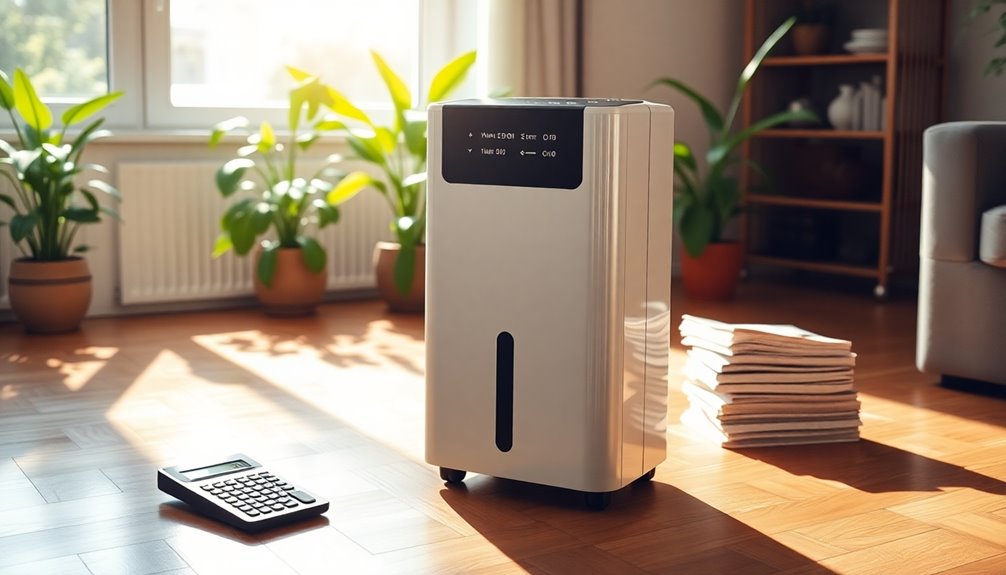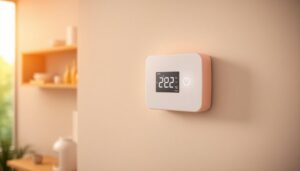Dehumidifiers can be a smart investment if you want to save on electrical bills. They operate more efficiently than air conditioners, using less power while managing indoor humidity. By keeping humidity levels below 50%, they make your space more comfortable and help your HVAC system run better. Energy-efficient models can cut energy costs by about 13%, and with proper use, you can see savings on your monthly bills. Plus, they help prevent mold issues, which can lead to costly repairs. To discover how you can maximize your savings, keep exploring your options and strategies.
Understanding Dehumidifier Functionality
Dehumidifiers work by efficiently pulling in humid air, which passes over a cooled metal surface where moisture condenses and collects in a reservoir. This process is vital for managing indoor humidity levels, especially when they exceed 50%.
At these higher humidity levels, air conditioning systems often struggle to maintain comfort, making a dehumidifier a valuable addition to your home. Additionally, using a dehumidifier can help improve automated investment management by creating a more comfortable environment that encourages productivity and focus on financial goals. Implementing budgeting tools can further enhance your financial planning as you invest in energy-efficient solutions.
When you're choosing a dehumidifier, consider its energy efficiency. Models vary in energy consumption, typically ranging from 300 to 800 watts per hour, which can greatly impact your electricity bills.
ENERGY STAR-rated dehumidifiers are designed to be more efficient, using about 13% less energy than standard models while effectively removing moisture.
To get the best performance from your dehumidifier, proper placement and regular maintenance are essential. Make sure it's located in a central area with good airflow and remember to clean the filters periodically.
Monitoring humidity levels will help you gauge its effectiveness and determine when it's time to adjust settings or service the unit. Additionally, understanding the importance of tracking financial goals can aid in making informed decisions about investing in energy-efficient appliances like dehumidifiers.
Evaluating Energy Consumption
When you evaluate energy consumption, it's essential to compare the wattage of different dehumidifiers and their operating costs. Understanding efficiency ratings can help you choose a model that saves you money in the long run. Additionally, utilizing price comparison tools can assist you in finding the best deals on energy-efficient models that meet your needs. Many of these tools, like Google Shopping, provide access to a wide range of products and valuable metrics that can enhance your shopping experience. Furthermore, using tools like Camelcamelcamel can help track price changes over time, ensuring you purchase at the optimal moment.
Energy Usage Comparison
Understanding the energy consumption of dehumidifiers is essential for managing your electric bills effectively. Most dehumidifiers use between 300 to 800 watts per hour, which can considerably impact your energy consumption and cost.
If you're looking to save money, consider investing in an Energy Star dehumidifier. These models consume about 13% less energy than their non-rated counterparts, making them a smarter choice for long-term savings.
On average, you can expect a dehumidifier to use around 4 kWh per day. At an electricity rate of 15 cents per kWh, this translates to roughly $18 monthly. Depending on the model, costs can range from $11.52 for a smaller 22-pint unit to $22.66 for a larger 50-pint version.
The efficiency of your dehumidifier is vital; Energy Star models typically remove about 1.85 liters of water per kWh, while older models may only manage 1.3 liters.
Being mindful of placement and usage strategies can also help minimize energy consumption. By making informed choices, you can keep your electric bills manageable while effectively controlling humidity levels in your home.
Operating Cost Analysis
To keep tabs on your energy expenses, it's crucial to evaluate the operating costs of your dehumidifier. Conducting an operating cost analysis can help you understand how much energy use translates to your electricity bill.
Here are four key factors to reflect on:
- Wattage: Dehumidifiers typically consume between 300 to 800 watts per hour. Higher wattage means higher costs.
- Runtime: Continuous use can considerably increase your monthly expenses. For example, a 50-pint unit running at 590 watts could cost around $22.66 monthly.
- Energy Efficiency: ENERGY STAR-rated models use about 13% less energy than non-rated ones, reducing operational costs.
- Proper Sizing: Oversized units may lead to increased energy consumption, raising your electricity bill even further.
Efficiency Ratings Explained
Efficiency plays an essential role in determining how much energy your dehumidifier consumes and, consequently, how much you'll pay on your electricity bill.
The Energy Factor (EF) is an important metric for evaluating energy consumption, measuring the liters of moisture removed per kilowatt-hour. If you choose an energy-efficient dehumidifier, aim for a model with an EF of 1.85 liters/kWh or higher, as this indicates superior energy efficiency compared to older models that may have an EF as low as 1.3 liters/kWh.
Your average dehumidifier consumes between 300 to 800 watts per hour, which directly affects the cost to run the unit. For instance, a 50-pint dehumidifier pulling around 590 watts can rack up an estimated monthly cost of $22.66 if used constantly.
To maximize efficiency and keep your energy consumption low, consider ideal placement and usage practices. Run the unit only when necessary, monitor humidity levels, and maintain the device regularly.
Financial Impact on Utility Bills
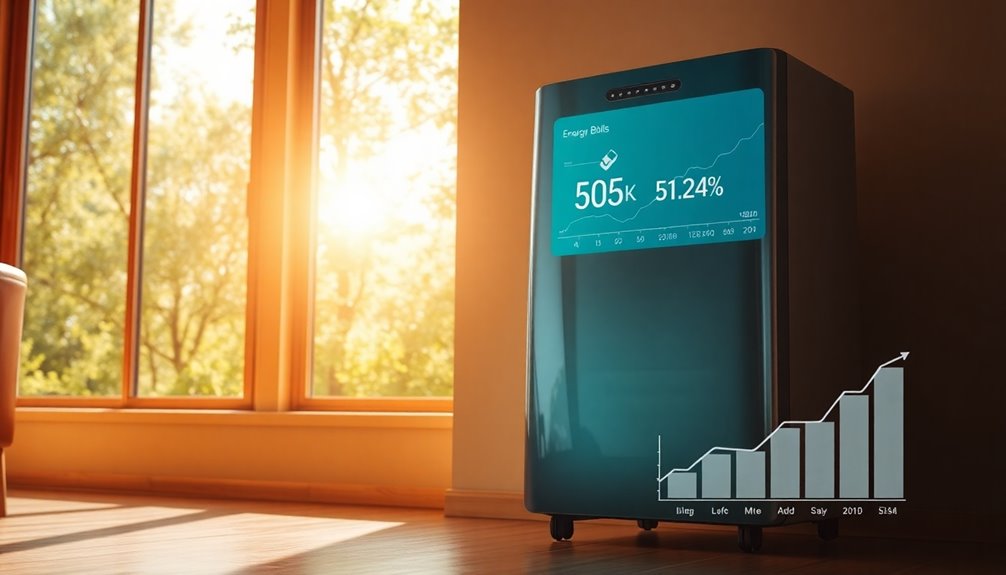
Using a dehumidifier can greatly impact your utility bills, offering a cost-effective alternative to running an air conditioner. When you consider the energy use, dehumidifiers work by consuming considerably less power than AC units, typically drawing around 100 volts compared to 220 volts. This difference can lead to substantial savings.
Here's how:
- Reduced AC Usage: Cutting back on air conditioner usage by just one hour a day can save you about $20 daily.
- Lower Operating Costs: Some ENERGY STAR-certified models cost only $11.52 to $22.66 per month to operate. Additionally, bill tracking apps can help you monitor any changes in your utility expenses over time. Tools like expense tracking tools provide comprehensive management features for organized business spending, aiding in financial clarity and stability.
- Extended AC Lifespan: By lowering humidity levels, dehumidifiers reduce strain on air conditioning systems, potentially extending their lifespan.
- Energy Efficiency: Efficient dehumidifiers use around 1.85 liters of moisture per kilowatt-hour, making them a smart choice for humidity control. Additionally, consistent use of a dehumidifier can contribute to improved financial management, reinforcing the importance of making informed decisions about energy consumption.
Comparing Dehumidifiers and Air Conditioners
When it comes to managing indoor climate, dehumidifiers and air conditioners serve different but complementary purposes. Dehumidifiers specifically target and manage humidity levels effectively, while air conditioners primarily cool the air.
If the humidity exceeds 50%, you might find that your air conditioner struggles to keep up, leading to discomfort and higher electric bills. AI-driven tools can also optimize your indoor climate management by providing data-driven insights into humidity and temperature levels.
Dehumidifiers use less energy, typically operating at around 100 volts compared to the 220 volts used by air conditioners. This lower energy consumption can greatly reduce your electric bill. Accurate categorization of utility expenses can further enhance your budgeting for energy costs.
By reducing humidity, a dehumidifier can also allow you to rely less on air conditioning, potentially saving you about $20 a day by enabling you to cut back on AC usage.
Whole-house dehumidifiers guarantee consistent humidity regulation throughout your home, enhancing comfort in ways that air conditioning alone can't achieve.
Additionally, integrating a dehumidifier with your air conditioning system can improve overall climate control, extending the lifespan of your AC unit by reducing operational stress. Moreover, utilizing expense management apps can further enhance your financial oversight by allowing you to monitor energy costs effectively.
When you compare these two options, it's clear that dehumidifiers play a vital role in efficient indoor climate management.
Benefits Beyond Energy Savings
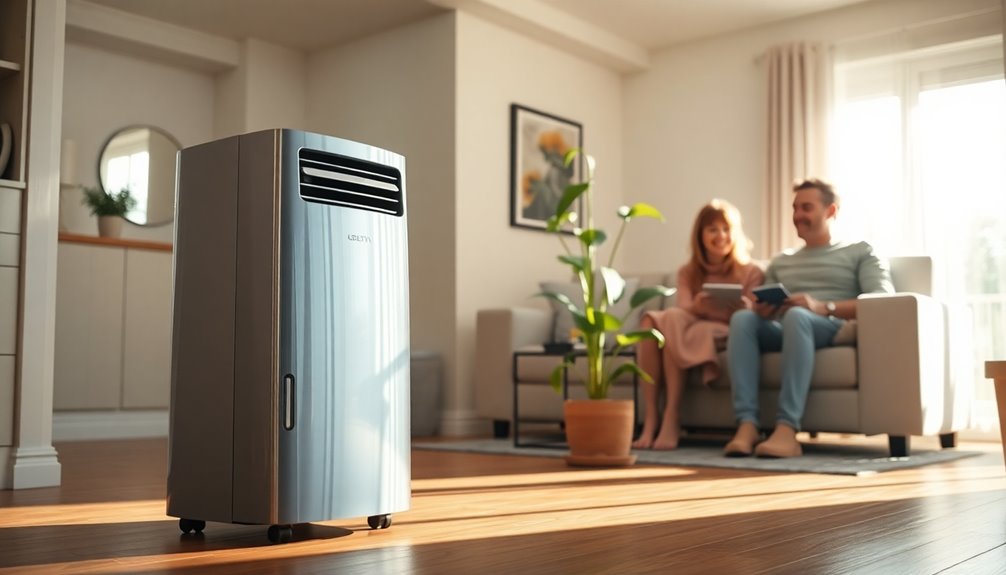
Here are some key advantages:
- Reduced Moisture Damage: Lower humidity levels help protect your furnishings and structural elements from moisture damage, extending their lifespan. Additionally, managing moisture effectively can contribute to reducing textile waste, as it helps preserve the quality of fabrics in your home.
- Mold Prevention: By minimizing humidity, you appreciably lower the risk of mold and mildew growth, leading to improved indoor air quality.
- Healthier Living Conditions: Consistent humidity control can decrease allergy and respiratory issues, creating a more comfortable space, especially for sensitive individuals.
- Extended HVAC Lifespan: Operating a dehumidifier can reduce the workload on your air conditioning system, prolonging its lifespan and cutting down on maintenance costs.
Investing in a whole-house dehumidifier guarantees consistent humidity regulation throughout your home. This not only enhances comfort but also contributes to overall home value, making it a worthwhile investment well beyond energy savings. Additionally, choosing a dehumidifier with sustainable packaging solutions can further support eco-friendly practices in your home.
Practical Cost-Saving Tips
To save on your electric bills while enjoying the benefits of a dehumidifier, consider several practical strategies. First, invest in an ENERGY STAR-certified model. These units can save you about 13% on energy costs compared to non-rated models, making a significant difference in your monthly bills.
Next, make sure your dehumidifier is appropriately sized for your space. An oversized unit can lead to unnecessary energy expenditure, driving up your costs.
Also, run your dehumidifier only when necessary. For instance, cutting back on its use by just one hour daily can save you around $20 each month.
Regular maintenance is important too. Clean the filters and empty the water tanks to keep your dehumidifier running efficiently, which in turn helps minimize energy costs.
Finally, use cost calculators based on your local electricity rates and the wattage of your unit. This will give you a clearer picture of your daily and monthly operating costs, allowing you to manage your budget effectively. Additionally, consider employing expense tracking apps that can help you monitor and control your overall energy-related expenditures.
Choosing the Right Dehumidifier
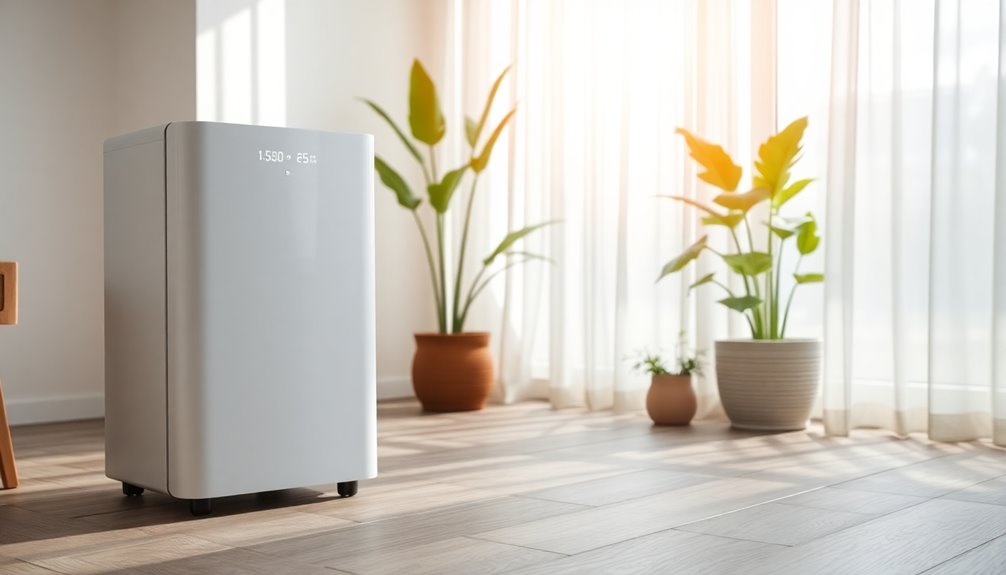
Selecting the right dehumidifier can greatly impact both your comfort and energy bills. When you're choosing a dehumidifier, consider these key factors to guarantee you make an informed decision that keeps humidity at lower levels while saving on energy costs:
- Energy Efficiency: Opt for ENERGY STAR-rated models, as they use about 13% less energy than non-rated units.
- Capacity: Assess the capacity needed, measured in pints per day. Larger units (70 pints/day) consume around 700 watts, while smaller ones (22 pints/day) may use as little as 300 watts.
- Size Appropriateness: Avoid oversizing your dehumidifier. It can lead to higher electricity costs and ineffective operation.
- Features: Look for humidity sensors and self-draining mechanisms, which enhance usability and guarantee the unit runs only as needed.
Customer Experiences and Feedback
Many customers have shared their positive experiences with energy-efficient dehumidifiers, highlighting significant reductions in their electricity bills. After installing these devices, many users report savings of up to $20 daily by cutting back on air conditioning usage. This consistent humidity control not only enhances your comfort but also reduces the frequency of AC operation, ultimately leading to lower energy costs.
Customers particularly praise ENERGY STAR-certified models, which use about 13% less energy than non-rated units. This efficiency translates into noticeable savings on your electric bill while still maintaining effective humidity levels.
User testimonials also emphasize the importance of professional assessments for ideal dehumidifier sizing. Getting the right size can maximize efficiency and boost your savings on energy consumption.
Additionally, many users note the long-term financial benefits, including reduced operational stress on air conditioning systems. This leads to extended lifespans and fewer maintenance costs.
Long-Term Savings Considerations
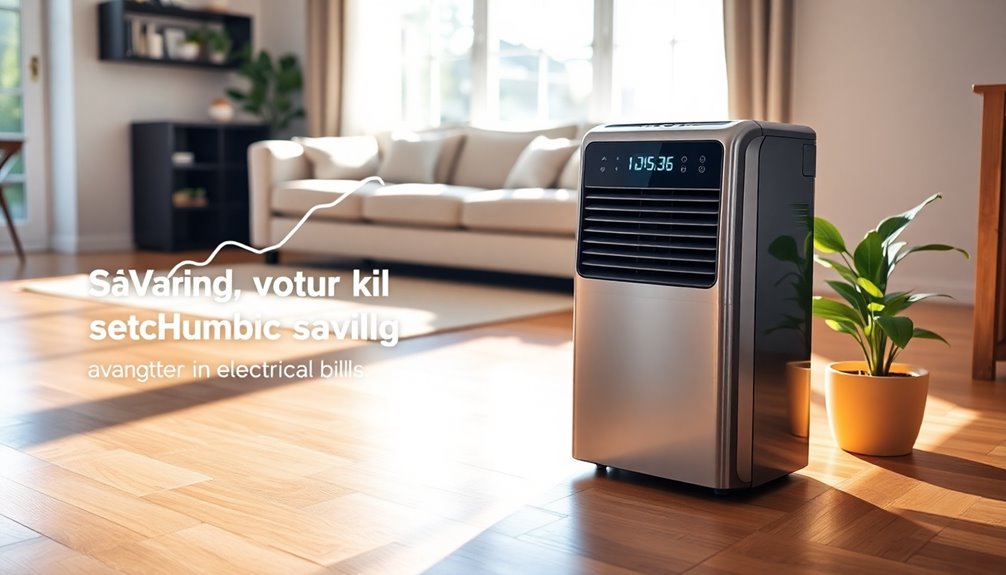
When you invest in an ENERGY STAR-rated dehumidifier, you're not just cutting down on energy costs; you're also reducing the wear and tear on your HVAC system.
This can lead to significant savings on maintenance and repairs over time.
Energy Cost Reduction
Achieving energy cost reduction is a smart financial decision for homeowners looking to lower their electric bills over time. By investing in an ENERGY STAR-rated dehumidifier, you can remarkably cut your power usage, leading to substantial savings.
Here's how it can save you money:
- Lower Energy Consumption: ENERGY STAR-rated models use about 13% less energy than non-rated ones.
- Reduced Air Conditioner Use: Controlling humidity can decrease your AC usage by an hour daily, saving you approximately $20 per day or $600 monthly.
- Optimized Power Usage: Choosing a properly sized dehumidifier minimizes unnecessary energy costs, with average consumption ranging from 300 to 800 watts per hour.
- Whole-House Solutions: These units not only regulate humidity efficiently but can also extend your HVAC system's lifespan, reducing long-term repair costs.
While continuous operation can lead to annual expenses over $300, strategic usage and proper sizing can effectively mitigate these costs.
Maintenance and Repair Savings
Investing in a dehumidifier not only cuts your electric bills but also provides significant maintenance and repair savings over time. By controlling humidity levels, you can protect your furnishings and structural elements from moisture damage, potentially saving thousands in repairs caused by mold and mildew.
When your dehumidifier runs efficiently, it helps maintain a balanced indoor environment, extending the lifespan of your air conditioning system. This means fewer repairs and maintenance costs for your HVAC unit, which often suffers from overuse in high-humidity situations.
Moreover, homes with managed humidity levels tend to have fewer allergy and respiratory issues. This can lead to long-term healthcare savings by minimizing doctor visits and medical expenses.
Investing in energy-efficient dehumidifiers enhances these savings, reducing both your utility bills and maintenance costs. Properly maintained dehumidifiers also improve indoor air quality, lowering the risk of mold infestations and the hefty expenses associated with mold remediation services.
Conclusion
To sum up, investing in a dehumidifier can not only enhance your home's comfort but also save you money. Did you know that a well-maintained dehumidifier can reduce energy costs by up to 20%? By controlling humidity levels, it lessens the workload on your air conditioner, ultimately leading to lower utility bills. So, if you're tired of high energy costs and want a more comfortable living space, a dehumidifier might just be worth it.

